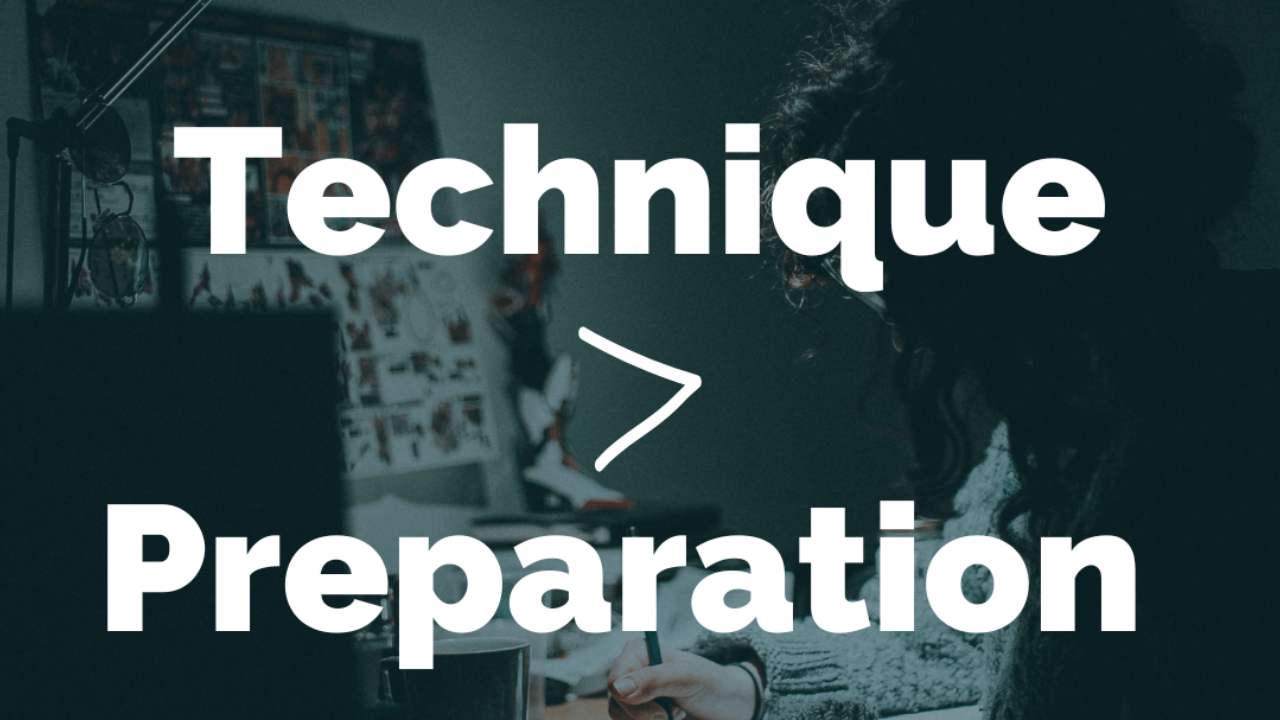A Scary Thing Worth Doing

I’m doing something scary next month…
It’s something I train my clients to do every single day, but as I see it looming on the calendar, I’ve got to admit—it’s still scary.
In one month, I’m taking the stage.
Not as a public speaker delivering a talk…
Not as an actor performing someone else’s piece…
In one month, I’ll be taking the stage as an actor in a show that I wrote.
And while I’m wildly excited to put the show in front of an audience, I’m not ashamed to admit that every step of the process has been SCARY.
Few things feel as vulnerable as standing up on a stage and sharing a message you’ve written and are passionate about.
I’ve found myself grappling with many of the same questions I help my clients work through every day.
“What if I have nothing to say?”
“What if this joke doesn’t land?”
“What if I crack on the high note?!?”
(Okay, that last one isn’t usually a concern for my clients, but to be fair, they don’t typically have to sing during their TED Talks. 😉)
I...
Public Speaking 101

I have a confession to make…I’m tired of repeating myself.
This past year, I’ve realized that there are certain concepts that I teach to every single client that I work with.
And with good reason! There are certain technique fundamentals that are prerequisites for becoming a world class public speaker.
When people don’t have access to those foundational ideas, they can waste a tremendous amount of effort and money.
- They’ll spend weeks laboring over their TEDTalk application without knowing the basic storytelling mechanics that would make them stand out
- They’ll spend thousands of dollars on a Speaker Reel, without learning the on-camera techniques that will make that a worthwhile investment
- They’ll practice their upcoming presentation to within an inch of its life, but be unable to quiet their nervous system enough to deliver on it
It kills me to see this.
I’m tired of watching people build their houses on sand.
That’s why I am so excited to announce the launch of Spe...
Waste Less Time Prepping for Speaking Engagements

"I'd love to learn how to become a more effective public speaker, but I just don't have time."
This is a sentiment I hear a lot as a public speaking coach, especially this time of year, as the weather gets nice and the siren song of the beach starts calling.
And look, I get it.
Skill-building sounds hard and time-consuming, and frankly, I'd rather go to a barbecue.
But here's the rub: investing time in honing a skill set is far more efficient than investing in honing a speech.
Paradoxically, I’ve found the people who claim they don’t have time to master the skill of public speaking are also the people who spend the most time preparing for individual presentations.
They'll spend weeks revising a pitch deck to within an inch of its life, only to show up at the big meeting and realize they don't have the right adapter to connect the projector.
They'll spend days memorizing a speech, only to end up sounding so robotic in their recitation that the whole room zones out immediately.
T...
Stick the Landing
Have you ever been gliding effortlessly through a presentation only to fumble at the very end? You're not alone. As I learned in the video above...endings are tricky. ;)
But here's the thing...
The two parts of your presentation an audience is most likely to remember are:
1. The Emotional Peak
2. The Ending
Which means, if you are in a time-crunch while preparing a presentation, those are the two moments I advice you focus on.
And while I'm not a big fan of memorization in general, I do think there's an argument to be made for memorizing the very last sentence you intend to say.
Otherwise, you may find yourself nailing a 90min presentation only to end things with,
"So, um, yeah, that's my presentation. Thank you. Um. Yeah, Thanks!"
Pay attention to those closers so you can end with a bang, not a whimper!
Dealing With a Defensive Audience

Here's a hard pill to swallow: Sometimes an audience doesn't want to hear what you have to say.
Sure, public speaking can be fun when you're delivering a wedding toast about how much you love your college bestie.
But what about when you're tasked with being the bearer of bad news?
- It's less fun to give a presentation to your work colleagues about why their last project flopped.
- Or giving a speech to your constituents about why they all need to take shorter showers in the midst of a drought.
- Or leading a training about how to identify unconscious biases when hiring.
Any time you tell an audience that they should change their behavior, you risk dealing with any speaker's nightmare: A defensive audience.
Looking into the crowd of frowning faces, you can almost hear their thoughts:
- Who is she to tell me how to live my life?
- I don't have to sit here getting judged by this person. What does she know?
- Okay, I get it. But does she have to be so preachy?
Oof. I'm s...
Do I Sound Stupid?

I have bad news...
Most audiences aren't going to let you know if you've lost them.
- Even if at the beginning of your presentation you say, "Please feel free to interrupt me when you have questions."
- Even if midway through your presentation you ask, "Is that all clear? Anyone have any questions?"
- Even if at the end of your presentation you say, "Now let's open things up to Q&A. Who has questions?"
It doesn't matter how many opportunities you give folks to get back on the path--most people simply won't let you know they're lost.
It breaks my heart, but it's the truth. Audience members are often reluctant to admit when they don't understand what a presenter is saying because they're afraid of looking stupid.
And the truly wild thing? Often the reason the audience is confused is because the presenter is afraid of the very same thing.
I've seen so many presenters completely lose their audience because they were so concerned with "sounding like an expert" that they spoke excl...
Why do stories work?

“Let me tell you a story”
To me, that is one of the most beautiful sentences in the human language. And fortunately for me, I get to hear it a lot in my line of work.
Story, my friends, is the word of the day.
Today I want to talk about the science of story and a simple trick for weaving storytelling into even the driest of presentations.
Here's a fun fact about Story:
When we hear a good story, our brains release oxytocin.
Oxytocin is one of those feel-good hormones that's specifically associated with trust and bonding. You can see why this might be especially powerful when you’re giving a presentation.
Perhaps you've heard that old business school adage, “We buy from brands that we know, like, and trust.”
Well, this doesn’t just apply to our shopping habits. We also buy into ideas from people that we know, like, and trust.
So, if you want to build trust with an audience, one of the best ways you can do that is to tell them a story.
Of course, not all stories are crea...
A Poem, A Picture, and a Puzzle

This morning I found myself in a bit of a creative rut. I sat down to write this blog and simply was coming up empty.
This is something clients complain to me about all the time.
“Sometimes I’m so terrified of saying the wrong thing, that I can’t think of anything to say at all.”
To which I usually say, “Okay, let’s practice saying “the wrong thing” and see what happens!”
It’s amazing what you can come up with when you lower the bar. When you sit down with the goal of writing a messy first draft as opposed to a Pulitzer prize winning novel.
Or…when you change the prompt altogether.
Today, I was feeling uninspired by the prompt of writing a blog.
So instead, I’m going to share with you a poem, a picture, and a puzzle.
A Poem
"Ode to a Zoom Meeting"
A baby cries.
A dog barks.
David, you’re on mute.
Can someone put the link in the chat?
A breakout room ends mid-joke.
David, you’re still on mute.
A man tries to leave a breakout room…
and leaves the meeting.
...Speak Before You Think: Public Speaking Hacks for Chronic Overthinkers

Are you a notorious straight-shooter who always says exactly what's on your mind without a moment's hesitation?
This blog is not for you.
Today, I want to talk to my overthinkers.
My friends who always think before they speak (sometimes to their own detriment).
Growing up, we're often told to “Think before we speak.”
This is excellent advice in general. Having a filter is a very useful thing in polite society. But, as with so many things in life, a trait that starts off as adaptive can very quickly become maladaptive.
Let’s talk about this idea of “the filter.”
When it comes to speaking, I like to think of verbal filters like curtains.
Each idea we have is a ray of sunlight.
In an ideal world, these rays are filtered through the curtain, letting an appropriate amount of light into the room.
People who have no filter often get in trouble for speaking without thinking.
They’ve built a house without curtains.
Sometimes the natural light can be refreshing, but often it’...
Why Preparation is Overrated

I'm feeling spicy this morning, so allow me to make a blasphemous claim about my industry:
When it comes to public speaking, preparation is good, but technique is better.
Now, am I saying you should wing your TEDTalk? Absolutely not.
But, I do think most of us are over-emphasizing the importance of “preparation.” (Or, at the very least, we’re defining “preparation” wrong.
You’d be amazed how many times a week I play out some version of this scene:
Future Client: I’m not bad at public speaking, as long as I have time to prepare.
Me: Okay, great! How often do you feel like you’re given adequate time to prepare?
Future Client: …almost never.
And therein lies the problem with relying on “preparation” when it comes to public speaking.
If you define “preparation” as spending hours outlining, drafting things out word for word, memorizing, and rehearsing in front of a mirror, you’re severely limiting the amount of opportunities you can say “yes” to.
Think about it: If the ke...


